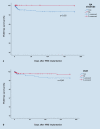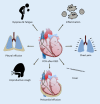Postcardiac injury syndrome after cardiac implantable electronic device implantation
- PMID: 32170340
- PMCID: PMC7581580
- DOI: 10.1007/s00059-020-04910-6
Postcardiac injury syndrome after cardiac implantable electronic device implantation
Abstract
Background: Postcardiac injury syndrome (PCIS) is an inflammatory complication that derives from injury to the epicardium, myocardium, or endocardium. It occurs after trauma, myocardial infarction, percutaneous coronary intervention, cardiac surgery, intracardiac ablation, and implantation of cardiac implantable electronic device (CIED). In this study we assessed the incidence of PCIS after CIED implantation and its possible risk factors.
Material and methods: All patients who received CIED implantation at Heidelberg University Hospital between 2000 and 2014 were evaluated (n = 4989 patients). Clinical data including age, sex, underlying cardiac disease, type of implanted CIED, location of electrode implantation, clinical symptoms, time of symptom onset of PCIS, therapy, and outcome were extracted and analyzed.
Results: We identified 19 cases of PCIS in 4989 patients, yielding an incidence of 0.38%. The age of patients with PCIS ranged from 39 to 86 years. Dilated cardiomyopathy (DCM) as underlying cardiac disease and right atrial (RA) lead implantation had a significant association with occurrence of PCIS (p = 0.045 in DCM and p < 0.001 in RA lead implantation). Dyspnea, chest pain, dry cough, and fever were the most frequently reported symptoms in patients with PCIS. Pericardial and pleura effusion as well as elevated C‑reactive protein (CRP), increased erythrocyte sedimentation rate (ESR), and leukocytosis were the most common findings.
Conclusion: To the best of our knowledge, this is the largest cohort evaluating the incidence of PCIS after CIED implantation. The data show that PCIS is a rare complication after CIED implantation and occurs more frequently in patients with DCM and those with RA lead implantation. Although rare and mostly benign, PCIS can lead to potentially lethal complications and physicians must be aware of its symptoms.
Hintergrund: Das Syndrom infolge Herzschädigung („post-cardiac injury syndrome“, PCIS) stellt eine inflammatorische Komplikation dar, die durch eine Schädigung des Epikards, Myokards oder Endokards hervorgerufen wird. Es kann nach einem Trauma, Herzinfarkt, einer perkutanen Koronarintervention, einem herzchirurgischen Eingriff, intrakardialer Ablation und Implantation eines kardialen implantierbaren elektronischen Systems („cardiac implantable electronic device“, CIED) auftreten. In der vorliegenden Studie wurden die Inzidenz des PCIS nach CIED-Implantation und mögliche Risikofaktoren dafür ermittelt.
Material und Methoden: Sämtliche Patienten, die am Universitätsklinikum Heidelberg zwischen 2000 und 2014 ein CIED implantiert bekamen, wurden in die Auswertung einbezogen (n = 4989 Patienten). Klinische Daten zu Alter, Geschlecht, zugrunde liegender Herzerkrankung, Art des implantierten CIED, Ort der Elektrodenimplantation, klinischen Symptomen, Zeitpunkt des PCIS-Symptombeginns, Therapie und Ergebnis wurden erfasst und ausgewertet.
Ergebnisse: Die Autoren fanden 19 Fälle von of PCIS unter 4989 Patienten, was eine Inzidenz von 0,38 % ergab. Das Alter der Patienten mit PCIS lag zwischen 39 und 86 Jahren. Eine dilatative Kardiomyopathie (DCM) als zugrunde liegende Herzerkrankung und die rechtsatriale (RA-)Elektrodenimplantation wiesen einen signifikanten Zusammenhang mit dem Auftreten eines PCIS auf (p = 0,045 bei DCM und p < 0,001 bei RA-Elektrodenimplantation). Dyspnoe, Brustschmerzen, trockener Husten und Fieber waren die am häufigsten angegebenen Symptome bei Patienten mit PCIS. Ein Perikard- und Pleuraerguss sowie eine Erhöhung des Werts für C‑reaktives Protein (CRP), erhöhte Blutsenkungsgeschwindigkeit (BSG) und Leukozytose stellten die häufigsten Befunde dar.
Schlussfolgerung: Nach Wissen der Autoren handelt es sich hier um die größte Kohorte, in der die Inzidenz des PCIS nach CIED-Implantation ermittelt wurde. Die Daten zeigen, dass PCIS eine seltene Komplikation nach CIED-Implantation ist und häufiger bei Patienten mit DCM und mit RA-Elektrodenimplantation auftritt. Auch wenn es selten und zumeist benigne ist, kann das PCIS zu potenziell tödlichen Komplikationen führen, Ärzte müssen sich daher seiner Symptome bewusst sein.
Keywords: Cardiac resynchronization therapy devices; Dilated cardiomyopathy; Pericardial effusion; Pericarditis; Right atrial lead implantation.
Conflict of interest statement
K. Filbey, F. Sedaghat-Hamedani, E. Kayvanpour, P. Xynogalos, D. Scherer, B. Meder, H.A. Katus and E. Zitron declare that they have no competing interests.
Figures



References
-
- Bucekova E, Simkova I, Hulman M. Postpericardiotomy syndrome—post-cardiac injury syndrome. Bratisl Lek Listy. 2012;113(8):481–485. - PubMed
MeSH terms
LinkOut - more resources
Full Text Sources
Medical
Research Materials
Miscellaneous

